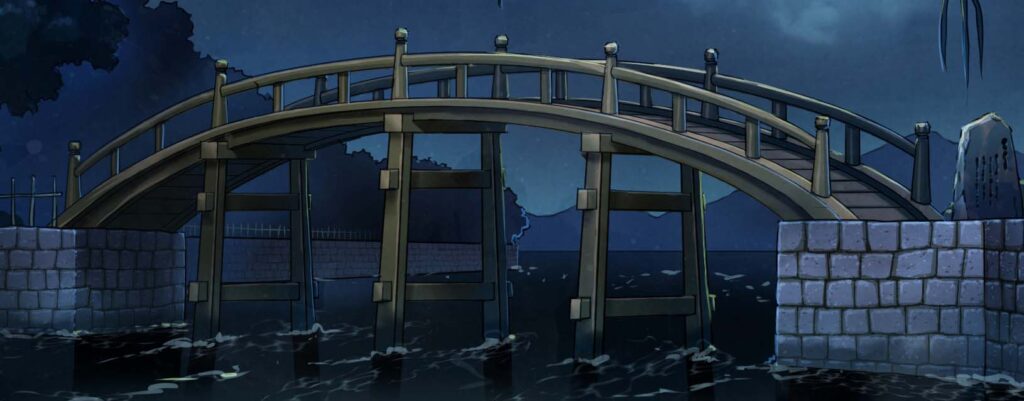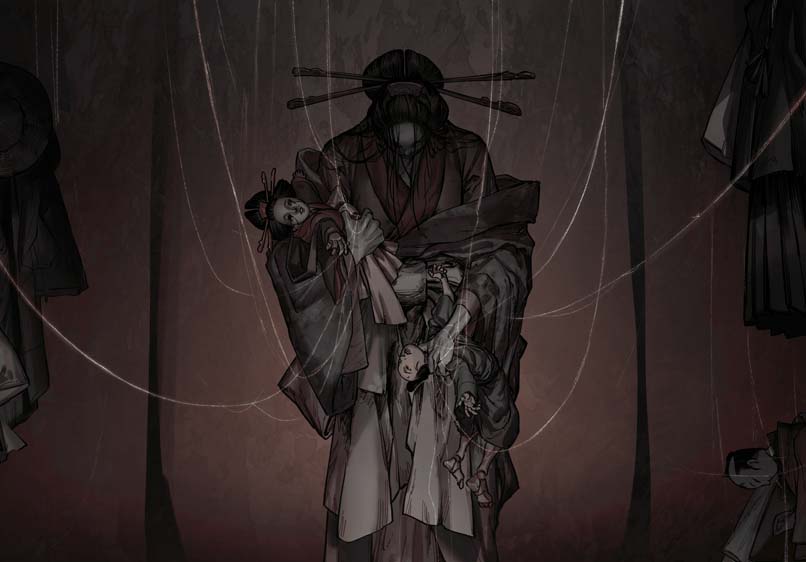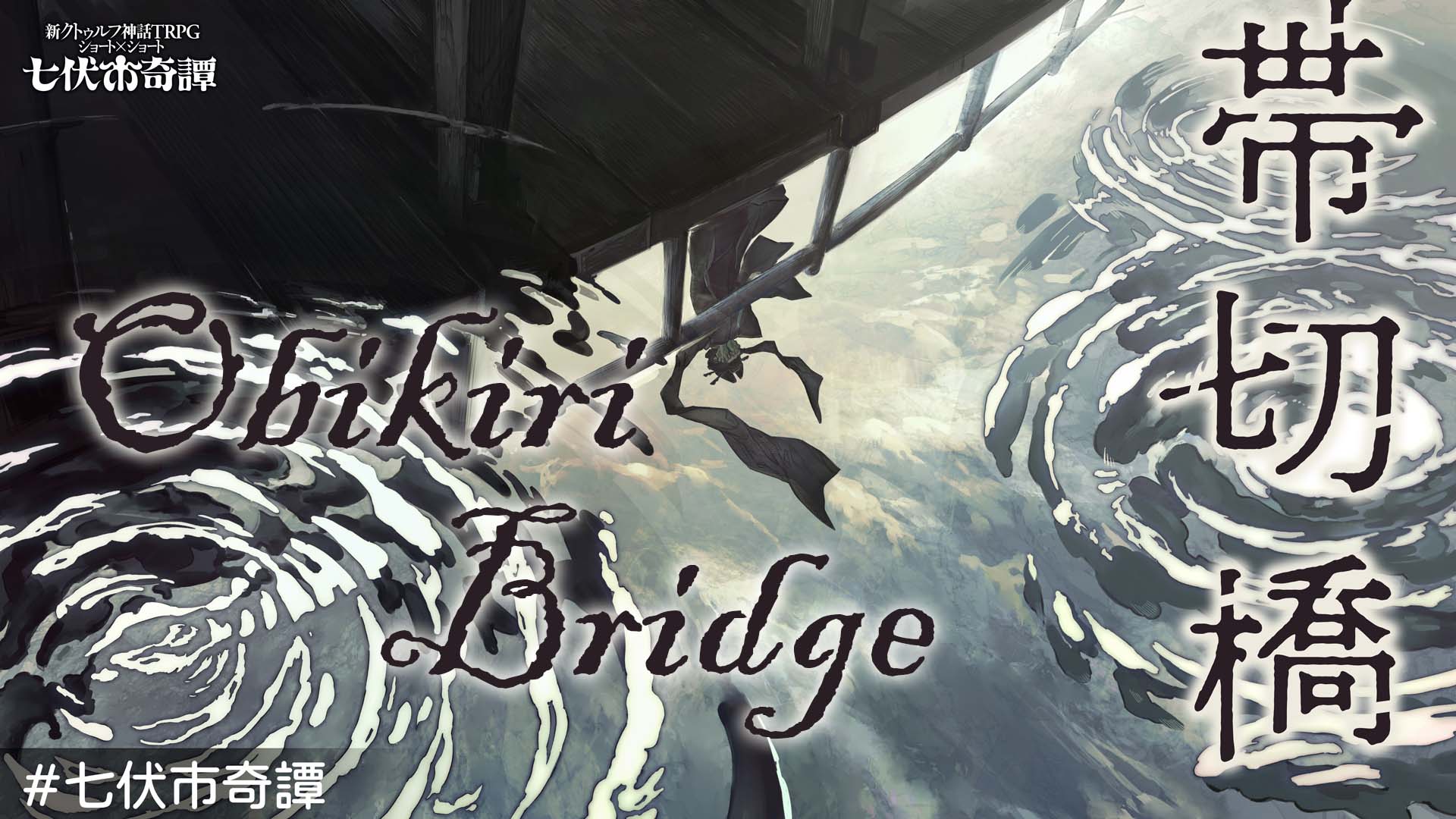The following is a review of the Japanese Call of Cthulhu scenario, Obikiri Bridge (帯切橋), written by Nanamine Kizashi and Gomi Hirufumi, published online by KADOKAWA as part of the ‘Tales of Nanafushi’ project.
In Short: A classic-styled ‘Kwaidan’ that works as a neat little story to experience but feels more like a visual novel stripped down and stuffed into a Call of Cthulhu scenario without allowing for much player creativity or, well, roleplaying.
Spoiler-lite for Players and Keepers
Obikiri Bridge is part of the ‘Tales of Nanafushi’ project started by Studio Arkham (or ‘Arkham Members’) and published by KADOKAWA. The idea behind the project is to make short, relatively easy to run, and online-focused scenarios for the ‘modern person.’ AKA, overly busy and terminally online workers and students (I feel targeted). Nanafushi is the shared setting, created as a sort of modern day, Japanese-version of Arkham, which can be shared by both official and community ‘doujin’ scenarios. When I ran this scenario, along with Cloud Jaws and Child Replay, for the A Weekend With Good Friends convention, a half dozen of the ‘Tales of Nanafushi’ scenarios were on sale in a bundle. The bundle is no longer available, but the individual scenarios can all be purchased on Booth or TALTO.
The project also frequently pairs Studio Arkham writers with creators from outside the TTRPG industry. In the case of Obikiri Bridge, Arkham Studio’s Nanamine Kizashi (who also wrote Cartoon Reanimation from Bibliothek 13 and another Tales from Nanafushi scenario, Cloud Jaws) is paired with Gomi Hirufumi, Japan’s premier Haunted House producer. Gomi is lauded for deepening audience participation in his works, with visitors actively engaging with the house’s backstory and characters. They are also right spooky. This does translate into Obikiri Bridge having a strong central story and characters that the investigators are made to learn about and directly interact with their backstory, as well as some set pieces and imagery worthy of a high-class haunted house.
The downside to this set dressing and detail is a fairly common one with CoC scenarios, more so in Japanese CoC scenarios, and it is in full force here, with the story happening at the players, rather than something they warp and create themselves via their characters (also known to some as roleplaying). The ‘investigation’ may be technically free form, but in most specifics the players and their investigators are expected to play along and do the text-prescribed actions. The heavy emphasis on non-player characters also results in one of RPGs deadliest sins – the GM read along between NPCs.
There are more read-along sections than normal (and I generally like to keep those to a minimum already…), and some of them are egregiously long. They could be cut or condensed in most cases, but I like to try running as close to the author-intended experience for a first run, for better or worse, and so slightly sidestepped the ‘droning GM’ problem by having the players do read-alongs like a grade-school English class reading of a play. Not in any way an elegant way of doing things, but it was kind of fun.
Normally the overly-detailed backstory is something of a negative trope in CoC scenarios, with the usual joke being the scenario author wanted to write a short story and so stapled it to the beginning of a scenario. In this case, though, the back story is the scenario. It feels like a classic Japanese horror myth, and there is quite a bit of fun in delving through layers of urban legends to piece together what’s really going on. Obikiri Bridge also uses language to a great extent, which does make running it in English a little tricky, but it also gives some excuses for mini grammar lessons. Hurray!

In detail, the scenario pdf is 13 pages long, with additional images and backgrounds in separate folders fit for VTT use. The scenario is up to the usual official release quality of both Studio Arkham and Chaosium, with frequent bullet points, boxed text, and little asides to break up the main text. It also has some moody scenery pictures, along with anime-style portraits. The additional images also have variations on the portraits for different emotions, in a very visual novel style. For the way I run, this isn’t something I would ever use, but for those more involved in setting up a video game-style VTT, go wild.
I could see a way to pry the scenario open to allow for more player creativity, but it would be difficult to do so without also erasing some of the unique atmosphere and set pieces. That could be a project for another day, and I’ll lay out some ideas in the Spoiler sections, but for now, I take Obikiri Bridge as a chance for Keepers and Players to experience a scenario outside of their usual comfort zones. If running it as-is though, it is definitely a one-and-done, as the rails won’t allow for much variation between runs.
Obikiri Bridge is currently only in Japanese, but it is available online as a pdf on Booth or TALTO, allowing for machine translation* to do most of the heavy lifting if needed.
*While the LLMs out there might seem like they can do all the translation in one fell swoop, they most certainly cannot. I tried using a few to see if it would be faster than a manual translation, and while they were certainly quick, they were liars. Frequently summarising paragraphs, making shit up whole cloth, or getting tripped up by formatting and missing entire pages. If you can do a read through and compare the two it might be the fastest method, but if not, you risk running something that is very much not the scenario you bought. For a complete non-Japanese speaker, a line-by-line Google Translate or similar method is still the safest bet.

Obikiri Bridge is a classic jilted lovers and fatal misunderstanding ghost story. A courtesan and a layabout carpenter fall in love, but a tragic accident results in the courtesan’s death. She drowns believing her lazy lover murdered her, and so she turns into a spooky J-horror ghost that wanders around on the Spring Tide to hypnotise and kill unsuspecting men. Que the investigators, one of whom should be an unsuspecting man.
The scenario doesn’t come with pregens (I swear Japanese scenarios hate pregens), but it assumes the investigators will all be university-age and coming back to Nanafushi to visit one of their grandmothers. This is to get around the slightly odd detail of every NPC they meet over the course of the scenario knows about, and aren’t overly concerned with, a ghost coming out once in a while and murdering people. This is something that could be smoothed over a bit by having a sort of Bloody Marry / Candyman-esque superstition that keeps the locals from wanting to say the ghosts name, but also gives room for a Library Use or Computer Use roll to find mentions of the ghost on some obscure internet forum.
By talking with various locals, reading some stuff, and watching a play, the investigators can learn the truth behind the urban legends, and figure out they need to solve the misunderstanding between the ghost of the courtesan and her lover (who is also still hanging around, and eventually possess an investigator, which is a good bit of fun). These investigative scenes can be pursued in any order, but they often play out very statically. The text doesn’t give much trust to the players or Keeper to find information on their own – the most blatant example being an old man in the opening that wanders out of the fog, tells the investigators the name of the ghost, then wanders off, as if they scenario is terrified the players might not think to find out the ghost’s name.
Along the way are heavy scripted scenes and set pieces, most of which have the ghost show up, do something spooky, then either leave or the investigators escape, often without the players having much say in what happens. This is most egregious in the finale, which has the investigators be trapped without any rolls or input, just ‘you’re stuck now, listen to the Keeper monologue for a bit.’ It’s a cool scene, with a bunch of possessed marionettes shooting out strings to grab and suspend the investigators. There could be some sort of metaphor going on there, with the player characters being forcibly puppeted by the scenario, but I doubt it’s intentional.

Most of these issues can be loosened up a touch by just letting the players do what they want and supplying information as makes sense, and pushing some of the ‘the ghost gets you!’ or ‘you get away from the ghost!’ behind a roll or two. If they get caught when they weren’t supposed to, then you got yourself some extra spooks. If they get away when they weren’t supposed to, then good on them. If they try to go somewhere unexpected? Let them, move a bit of usual information there. Pretty basic investigative RPG GMing advice, I know, but it would be nice if the scenario would be less rock-solid in its assumptions and prescriptions. For example, there’s an island where the courtesan and her John met and is frequently mentioned throughout the scenario, but it gives no way to get there, and no suggestions of what to do there.
While most of that is fairly negative, I did enjoy my run of Obikiri Bridge, and the players said they had fun as well (though I doubt many players would announce to their convention GM how shit of a time they had…). As with many official Japanese scenarios, the atmosphere creates a firm sense of place, the characters are evocative, and the set pieces are nice and creepy. Obikiri Bridge also dives head first into the style of a traditional Japanese ghost story and does fun stuff with language and urban legends. It has its issues, but I still firmly think it’s worth a run if you and your players are at all interested in the subject, or want to try something different.
Again, Obikiri Bridge is currently only in Japanese, but it is available online as a pdf on Booth or TALTO.




